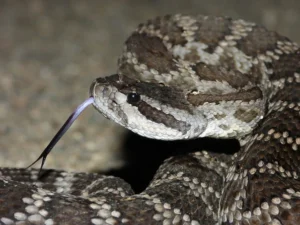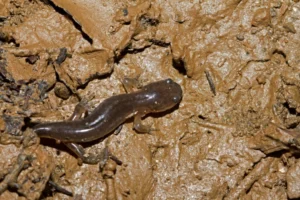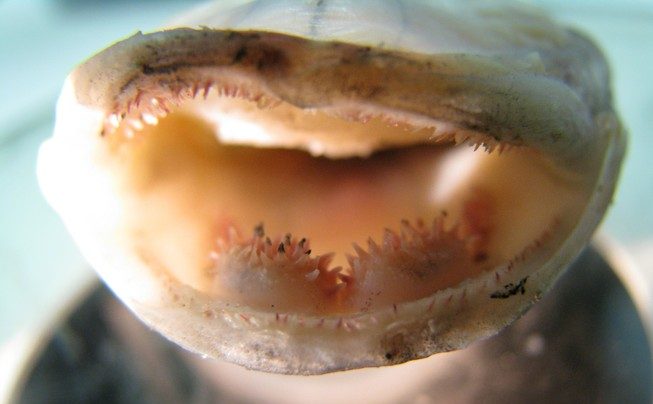Salamanders are secretive, soft-skinned amphibians that spend their time under logs, near streams, or tucked into damp soil. They are quiet animals, rarely seen in the open, and move with a slow, deliberate pace. This often leads people to wonder: do salamanders have forked tongues?
Salamanders do not have forked tongues. Their tongues are broad, smooth, and sticky, built for quickly catching prey. Unlike reptiles, salamanders rely on sight, touch, and smell rather than tracking chemical trails with their tongues.
Their tongues are not for chemical tracking like those of snakes or lizards. Instead, salamanders use their tongues to grab prey efficiently in moist, shaded environments.
Salamanders Use Broad Tongues, Not Forked Ones
When people imagine a forked tongue, they often think of snakes flicking their tongues to sample scents.
These tongues split at the tip, letting reptiles “taste” the air or ground and send chemical cues to a special organ in the roof of the mouth.

Salamanders do not have this system.
Their tongues are:
- Smooth, without a fork or split
- Fleshy and wide, not narrow or pointed
- Covered in sticky mucus for catching insects
- Anchored near the front of the mouth for fast projection
Their tongue is built for grabbing prey, not sensing chemicals. This shows how salamanders adapted to their own wet, shaded habitats full of invertebrate food.
A Closer Look at Salamander Tongue Anatomy
A salamander’s tongue reflects its purpose. Unlike reptiles that hunt by scent, salamanders mostly rely on sight or sensing movement.

Once prey is spotted, the tongue does the work.
Key features include:
- A broad surface for grabbing larger areas
- Sticky coating to latch onto insects or worms
- Flexible base for movement in multiple directions
- Smooth tip with no fork
The tongue is usually folded inside the mouth and springs forward when prey comes into view. This design is especially useful for catching fast-moving ants, beetles, or tiny snails.
How Salamander Tongues Work During Feeding
One impressive trait is the ability to shoot the tongue forward quickly. This is most notable in lungless salamanders (family Plethodontidae).
The process works like this:
- The tongue is coiled inside the mouth
- Muscles contract to launch it out
- Sticky surface grabs the prey
- The tongue retracts, pulling food into the mouth
In some species, this happens in less than a tenth of a second. The tongue can extend up to half or twice the salamander’s body length.
This is called ballistic tongue projection, letting salamanders stay still and hidden while catching food just out of reach.
Why Salamanders Never Evolved Forked Tongues
Forked tongues in reptiles help track scents in dry environments. They flick the tongue to detect chemical trails from prey, predators, or mates.
Salamanders live in different conditions. Most prefer wet environments where chemical signals spread differently.

Instead of using tongues to sense distant chemicals, salamanders rely on:
- Nostrils for smelling nearby scents
- Skin receptors that detect moisture and particles
- Direct contact with surfaces rather than air sampling
Their tongues are better suited for catching food than analyzing chemicals.
How Reptile Tongues Work in Comparison
Reptiles use their tongues both for sensing and feeding. Snakes flick forked tongues constantly to sample the environment. Each fork collects scent from different directions, letting them compare chemical levels.
These particles go to the Jacobson’s organ (vomeronasal organ), which interprets chemical signals. Salamanders do not use their tongues this way.
They have no fork, no Jacobson’s organ in this form, and no need for long-range chemical tracking. Their senses focus on close contact.
Other Uses of the Tongue in Salamanders
The tongue also helps in minor ways:
- Tasting food to check safety or nutrition
- Licking surfaces or their skin to collect moisture or sense chemicals
- Grooming, especially around eyes and face
These actions are occasional and supportive. The tongue mainly remains a feeding tool, not a sensor or communication organ.
Tongue Differences Among Species
Not all salamanders use their tongues the same way. Tongue size, shape, and strength match habitat and diet.
- Terrestrial salamanders have long, sticky tongues for grabbing insects on land.
- Aquatic salamanders often rely on suction feeding, using the tongue less.
- Neotenic species, like axolotls, have limited tongue projection and use jaw motion or suction.
Some tongues shoot forward up to twice the body length, while others mainly push food into the mouth. Each type suits a specific lifestyle.
Fast tongues catch insects in forests, slower tongues work in calm ponds.
What the Tongue Does Not Do
Salamander tongues have limits. They do not:
- Play a major role in communication
- Signal other salamanders or produce sound
- Track distant chemical trails like reptile tongues
Instead, salamanders use skin glands, smell receptors, and body movements to find information and communicate. The tongue remains primarily a feeding tool.
Conclusion
Salamanders do not have forked tongues. Their tongues are broad, sticky, and smooth, designed for catching prey rather than detecting chemicals in the air.
Unlike reptiles, salamanders depend on other senses (smell, touch, and sight) to survive in wet habitats. ry.
Hi, my name is Ezra Mushala, i have been interested animals all my life. I am the main author and editor here at snakeinformer.com.

